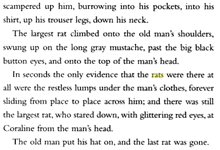Visual Storytelling
Visual Storytelling
Compare an excerpt from the graphic novel above with the traditional format book. Click the images above for a close-up.
Read classics and create one-page visual summaries of chapters. Use children's graphic novels such as those from Stone Arch books for inspiration.
Involve young people in visualizing existing stories or writing their own graphic novels. Provide photos to stimulate writing activities. Consider before/after photos or a series of images. If possible, provide cameras for storytelling.
Read the award-winning graphic story by Geoffrey Hayes called The Big No-No, then used the online Cartoon Maker to retell the story or write their own story. Using the graphic story provided a new format for reading, while the cartoon making tool providing scaffolding for a story writing assignment.
Try It!
Try to Cartoon Maker from Toon-Books.
Language Development
Use the Learn Spanish with Superman series from Berto get language learners involved with learning and writing in a foreign language.
- Provide photos and ask students to write dialog.
- Crop a single photo and use different elements to tell a short story with dialog.
- Develop characters from photos and write short visual stories
- Provide dialog in two languages


Try It! Create a Dialog
Right-click and save Story.ppt. Write dialog based on one of the photos. Can you write the dialog in both English and Spanish? If you have a microphone, record audio of the conversation.
Try It! Use MakeBeliefsComix
Some online tools are effective for projects that involve writing dialog. Go to MakeBeliefsComix and create a short comic.
 Creative Writing
Creative Writing
Use visual resources as prompts for writing. Postcards provide a great start. Young people can use existing postcards or create their own for storytelling. Go to Flat Stanley for examples of Flat Stanley postcards. Go to Photo Safari for more ideas.
Use Postcards: True Stories that Never Happened edited by Jason Rodrigez to jumpstart an illuminated project based on postcards. Ask young people to develop a story based on a postcard. Go to the book website to learn more about it and see examples from the book.
Think about ways that young people can explore, analyze, and write tall tales, fairy tales, folklore, and myths. Start by reading tall tales such as Apples to Oregon by Deborah Hopkinson & Nancy Carpenter. Look for books by Steven Kellogg. Use exaggerated postcards to jumpstart an illuminated story. Download the Let's Tell Tall Tales (PPT) PowerPoint Sidekick. Go to W. H. Martin at Wikipedia for examples of tall-tale postcards. For additional ideas, go to Sidekicks: Stories.






